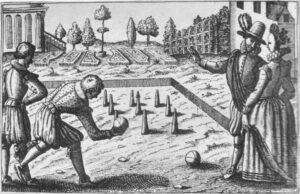The Ancient Elegance and Modern Evolution of Lawn Bowling

The Elegant Game
Introduction:
Lawn bowling, a sport often associated with serene gardens and well-manicured lawns, is a game with a rich history and a fascinating evolution. Originating from ancient civilizations, lawn bowling has transitioned from a royal pastime to a popular sport enjoyed by people of all ages and backgrounds. In this article, we’ll take a journey through time to explore the history of lawn bowling and how it has evolved into the game we know today.
Ancient Beginnings:
The roots of lawn bowling can be traced back thousands of years, with evidence of similar games found in ancient Egypt. Archaeologists have uncovered stone bowls and skittles, suggesting that early Egyptians played a form of bowling more than 5,000 years ago. These games likely laid the foundation for what would later become lawn bowling.
Roman Influence:
The Romans, who had a penchant for adopting and adapting elements of the cultures they encountered, developed their own version of the game. Known as “bocce,” this Roman bowling game involved rolling a smaller ball (the “jack”) to establish a target and then trying to get larger balls as close as possible to the jack. Bocce, which still exists today, provided a blueprint for lawn bowling’s basic rules.
Medieval Europe:
Lawn bowling as we know it began to take shape in Medieval Europe. It was during this time that bowling greens, the well-maintained lawns required for the game, first appeared. Bowling greens were often found near monasteries and were used for relaxation and recreation.

An Ancient Game
Tudor England:
Lawn bowling gained popularity in England during the Tudor period, especially among the nobility. King Henry VIII was an avid bowler, and the sport became associated with the upper class. In 1511, Henry VIII famously banned bowling for those who weren’t wealthy landowners, as it was deemed a distraction from archery practice. However, it continued to flourish among the aristocracy.
The Birth of Modern Lawn Bowling:
The 19th century saw the development of the modern form of lawn bowling. The establishment of the “rules of the green” in Scotland in 1848 marked a significant turning point. These rules standardized the game, including the length of the bowling green and the distance between the jack and the bowls. This standardization made it possible for clubs and competitions to emerge.
The Spread of Lawn Bowling:
Lawn bowling quickly spread beyond the British Isles. The game gained popularity in Canada, Australia, New Zealand, and the USA, where numerous clubs were established. These clubs introduced their own variations and formats, contributing to the game’s diversity.
![]()

Yes, for sure, give it a try!
Lawn Bowling Today:
Lawn bowling has continued to evolve and adapt to the modern world. While the fundamentals of the game remain unchanged, innovations such as synthetic greens and modified rules have made it more accessible to a wider audience. It is no longer solely the domain of the elite; people of all ages and backgrounds now participate in the sport.
Conclusion:
Lawn bowling’s journey through history is a testament to its enduring appeal. From ancient civilizations to modern clubs, this sport has adapted and thrived, bringing together people in pursuit of leisure, competition, and camaraderie. Its rich history and evolution make it a beloved tradition that continues to roll on, enchanting new generations with its grace and strategy. Whether played in a historic club or a community park, lawn bowling remains a timeless and elegant pursuit.





























































